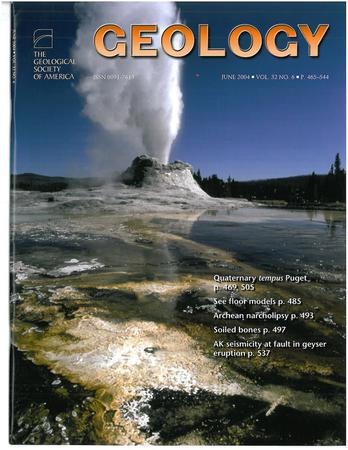Boiling-induced extreme Cu isotope fractionation in sulfide minerals forming by active hydrothermal diffusers at the Aegean Kolumbo volcano: Evidence from in situ isotope analysis
IF 4.8
1区 地球科学
Q1 GEOLOGY
引用次数: 0
Abstract
We analyzed the first Cu isotopes in primary cupreous pyrite and orpiment, from modern CO2-degassing, seafloor massive sulfide diffuser vents (“ΚCO2Ds”), from the Kolumbo submarine volcano, Hellenic volcanic arc. Samples came from six ΚCO2Ds that are actively boiling. Pyrite comprises colloform pyrite-I and euhedral pyrite-II, which occur erratically distributed within the ΚCO2Ds and are contemporaneous with barite and spatially concurrent with the chalcopyrite that is lining narrow internal conduits, respectively. Orpiment occurs on the outer walls of the KCO2Ds with barite and stibnite. The δ65Cupyrite-I values show high variability, ranging from +2.93‰ to +6.38‰, whereas the δ65Cupyrite-II and δ65Cuchalcopyrite values vary from −0.94‰ to +0.25‰ and −0.45‰ to −0.09‰, respectively. The range of δ65Cuorpiment between +1.90‰ and +25.73‰ is the most extreme ever reported from any geological setting. Pyrite-I is concentrically layered, with a core comprising random crystallites, whereas the mantle crystallites have grain-size, shape, and orientation variability between layers. Pyrite-II forms aggregates of uniform euhedral pyrite crystals. Pyrite-I has higher concentrations of Cu (≤21,960 ppm) compared to pyrite-II (≤4963 ppm), and both have incompatible and volatile metal(loid)-rich composition and low Sb/Pb (<0.5) and Tl/Pb (<0.03) ratios. When combined with evidence for significant magmatic contributions at Kolumbo and geochemical and micro-textural evidence for recurrent intense boiling and/or flashing or gentle and/or non-boiling, the measured extreme δ65Cu values are consistent with transport of Cu by vapor that is preferentially enriched by heavy 65Cu and controlled by continuous Rayleigh distillation−type Cu fractionation. Boiling-induced Cu vapor transport can generate extreme Cu isotope fractionation.爱琴海科伦坡火山活动热液扩散器形成的硫化物矿物中沸腾诱导的极端Cu同位素分馏:来自原位同位素分析的证据
我们分析了原始铜黄铁矿和雌黄中的第一批铜同位素,这些同位素来自现代CO2脱气、海底块状硫化物扩散喷口(“κCO2Ds”)、科伦博海底火山、希腊火山弧。样本来自六个活跃沸腾的κCO2Ds。黄铁矿包括胶体黄铁矿-I和自形黄铁矿II,它们不稳定地分布在¦ΒCO2Ds内,分别与重晶石同时存在,并在空间上与衬在狭窄内部管道中的黄铜矿同时存在。重晶石和辉锑矿出现在KCO2Ds的外壁上。δ65Cupyrite-I的值变化很大,范围从+2.93‰到+6.38‰,而δ65CuPyriteII和δ65Cu黄铜矿的值分别从-0.94‰到+0.25‰和-0.45‰到-0.09‰。δ65Cu在+1.90‰和+25.73‰之间的范围是任何地质环境中报道的最极端的。黄铁矿-I呈同心层状,其核心包含随机晶粒,而地幔晶粒在各层之间具有晶粒大小、形状和取向变化性。黄铁矿II形成均匀自形黄铁矿晶体的聚集体。与黄铁矿II(≤4963ppm)相比,黄铁矿I具有更高的Cu浓度(≤21960ppm),并且两者都具有不相容和挥发性金属(类)富集成分,并且Sb/Pb(<0.5)和Tl/Pb(<0.03)比率较低。当与科伦博重大岩浆贡献的证据以及反复强烈沸腾和/或闪光或温和和/或不沸腾的地球化学和微观结构证据相结合时,测得的δ65Cu极值与蒸汽输送Cu一致,蒸汽优先富集重65Cu,并由连续瑞利蒸馏-型Cu分馏控制。沸腾诱导的铜蒸气传输可以产生极端的铜同位素分馏。
本文章由计算机程序翻译,如有差异,请以英文原文为准。
求助全文
约1分钟内获得全文
求助全文
来源期刊

Geology
地学-地质学
CiteScore
10.00
自引率
3.40%
发文量
228
审稿时长
6.2 months
期刊介绍:
Published since 1973, Geology features rapid publication of about 23 refereed short (four-page) papers each month. Articles cover all earth-science disciplines and include new investigations and provocative topics. Professional geologists and university-level students in the earth sciences use this widely read journal to keep up with scientific research trends. The online forum section facilitates author-reader dialog. Includes color and occasional large-format illustrations on oversized loose inserts.
 求助内容:
求助内容: 应助结果提醒方式:
应助结果提醒方式:


